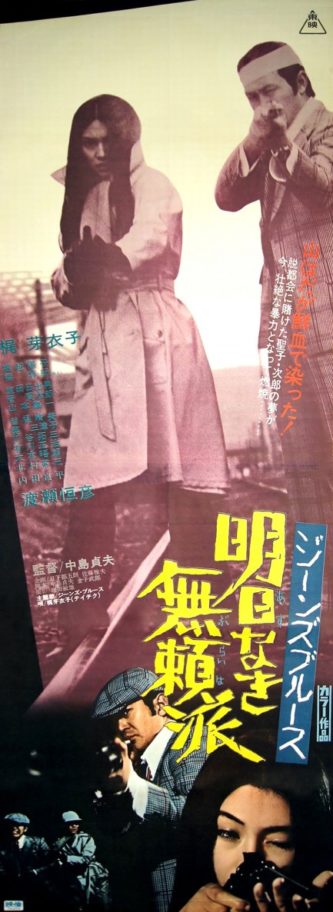 Japanese “Pinky violence” from 1974 that’s said to have been inspired by BONNIE AND CLYDE. It certainly contains more than its share of lurid sex and violence, but JEANS BLUES: NO FUTURE (JINZU BRURUSU: ASU NAKI BURAIHA) works because of its jazzy and artful visuals, and also the presence of the Japanese trash movie superstar Meiko Kaji, who was in excellent form here.
Japanese “Pinky violence” from 1974 that’s said to have been inspired by BONNIE AND CLYDE. It certainly contains more than its share of lurid sex and violence, but JEANS BLUES: NO FUTURE (JINZU BRURUSU: ASU NAKI BURAIHA) works because of its jazzy and artful visuals, and also the presence of the Japanese trash movie superstar Meiko Kaji, who was in excellent form here.
It begins at a house party attended by Hijiriko (Kaji), a bored young woman who feels that “nothing is fun anymore.” She leaves the party in her car, while nearby a young drifter named Jiro (Tsunehiko Watase) is assisting some Yakuza colleagues in the torture-murder of a corrupt businessman. During the melee a large sum of cash is dropped and snatched up by Jiro, who promptly drives off. He ends up colliding on the road with Hijiriko, and inadvertently blowing up both their cars. Yet these two have an immediate connection, and take off in the car of a man who has the misfortune to stop off in the area. In the process the man is severely injured, thus rendering Jiro and Hijiriko criminals.
The two get to know each other during a coffee shop stop-off. Hijiriko admits to having felt a real thrill upon seeing the cars explode, and agrees to accompany Jiro on his outlaw odyssey. They embark on an aimless spending spree in Kyoto, which concludes with Jiro idiotically losing all his money—and in the process attracting the attention of two policemen! He’s saved by Hijiriko, who commandeers their car and snatches him up before the cops can nab him.
Jiro’s jilted Yakuza colleagues, meanwhile, are hot on his trail, and nearly catch up with him. This entails a car chase, a mad dash and the loss of one of Hiro’s fingers. The following day brings more mayhem, with Jiro and Hijiriko shooting a hunter and holding up a gas station. Their bad decision-making reaches its apex when they decide to rob a yakuza gambling den, during which several people are killed and the police are once again alerted to the outlaws’ presence. This seals their fate, which is foretold by the second part of the title, and is much darker than that of Bonnie and Clyde.
The proceedings are marked by colorful visuals and widescreen compositions that, as in quite a few vintage Japanese exploitation films, seems more suited to an art film than the unapologetic trash-fest JEANS BLUES: NO FUTURE is. There’s also copious softcore sexuality (albeit confined mostly to the early scenes) and violence that’s plentiful but never very convincing, relying as it does on dramatic music cues, cartoony sound effects and excess blood spurts.
Neither of the outlaw protagonists are ever too sympathetic, although Meiko Kaji, as she proved in similarly minded fare like the FEMALE CONVICT SCORPION and LADY SNOWBLOOD films, is a profoundly arresting screen presence. Some of the film’s most compelling images are the many lingering close-ups of her gorgeously expressive face, which is quite a sight to behold. Rounding things out is a funky music score to remind us of the decade in which the film was made.
Ultimately, JEANS BLUES: NO FUTURE may not be the “classic” some grindhouse fanatics have dubbed it, but it utilizes its attributes—sex, violence and Meiko Kaji—exceptionally well.
Vital Statistics
JEANS BLUES: NO FUTURE (JINZU BRURUSU: ASU NAKI BURAIHA)
Toei Company
Director: Sadeo Nakajima
Screenplay: Takeo Kaneko, Sadeo Nakajima
Cinematography: Toshio Masuda
Cast: Meiko Kaji, Tsunehiko Watase, Ryohei Uchida, Hideo Murota, Takuzo Kawatani, Eriko Kano, Yoko Horikoshi
